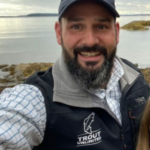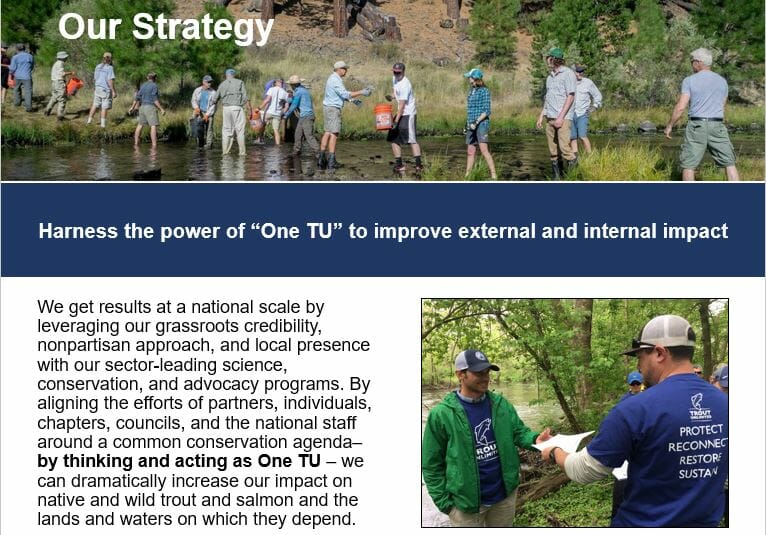A focus on driving “One TU” forward, with emphasis on engagement and a new membership model are among the major points in the early drafts of the new Trout Unlimited Strategic Plan. The organization has engaged the firm Bernuth & Williamson to lead the staff and volunteers through the process and has developed a working team as well as an advisory committee to ensure all parts of TU have a voice in the plan’s development.
To date, Chris Wood our president and CEO has had several meetings with volunteers to discuss the plan, including three calls with NLC representatives and state Council chairs, and three calls with chapter presidents. Feedback and suggestions from our grassroots has driven the continued evolution of the draft plan.
Watch Chris’ Sept. 30 call with Volunteer Leaders
Strategic Plan Goals
In the new draft strategic plan, we outline three driving goals behind our efforts:
- Care for and recover a national network of resilient priority waters for native and wild trout and salmon.
- Create an inclusive and equitable organization that invites all people to advocate for and participate in the care and recovery of our lands and waters.
- Invest in people – staff, volunteers, and partners – so we have the tools, technology, training, and resources necessary to achieve our shared g
The first goal defines how we will approach the conservation and restoration of wild and native trout streams by focusing on priority waters where the science shows investments of time, talent and treasure will achieve the greatest results. This will encourage collaboration between staff and volunteers to assess priority watersheds, identify the greatest threats and opportunities and work together on multi-year and multi-tactic restoration efforts.
The second goal, importantly, elevates people in our plan and recognizes that it is the community element of TU, through our grassroots system of chapters and councils, that is one of the main differentiating strengths of our organization compared to many other conservation nonprofits. With engagement of individuals representing the whole community playing a central role, we can marshal an even greater volunteer base to accomplish significant conservation and advocacy outcomes.
Finally, the third goal highlights the need for significant investment in the staff, chapters and councils – as well as the tools and technology we will rely on to collaborate more effectively.
Operationalizing “One TU”
“One TU” is a concept developed by Chris Wood that envisions an organization where all aspects of our structure from chapters to national staff work in concert to achieve shared goals. In the future, this may include deeper involvement and support of volunteer projects by field staff, our communications department and more.
As part of the strategic planning process, TU envisions “operationalizing” the concept of “One TU” by investing more in collaboration between grassroots and staff. This might include connecting more field staff to their local chapters and state councils to develop and define priority conservation and community projects and work together to drive them forward.
A staff member might, for instance, provide specialized training of local volunteers on conducting assessments of small dams, culverts and other barriers to fish passage, and then direct those volunteers as they assess the tributaries feeding into a local watershed. The groundwork conducted by the volunteers then feeds the next several years of removal and reconnection projects – re-opening critical habitat for wild and native trout and salmon.
Engagement – Not Just Dues
Engagement plays a critical role in the new plan, with a major goal being to change our membership model to welcome as members anyone who volunteers their time and participates in local Trout Unlimited events, whether or not they pay an annual membership fee.
Currently, the only way into the door to become a “member” of Trout Unlimited is to pay annual membership dues through an appeal – or to join via a free “trial” membership program by participating in an Orvis class, attending a Fly Fishing Film Tour event etc…
The goal long-term is to grow our community and provide more people with information, and opportunities to connect to the TU mission the way they want to and through the channels they choose.
Under this new model of engagement, TU would invest in tools and training to help our chapters and councils continue to build their local communities. Any member, supporter or participant in a local event or activity – whether they plant a tree, pick up trash, write a letter to advocate for a new state riparian buffer bill or simply bring their family to a kids fishing day – would be offered a free TU membership and begin to receive information from TU at all levels that is relevant to their interests.
Fundraising would still remain a necessary part of fueling our work together, but in this new model, people would be given opportunities to support TU efforts that are meaningful to them.
Feedback Welcome
Please take the time to watch Chris’ presentation to volunteer leaders, then reach out with questions, suggestions or ideas how we can continue to adjust this new strategic plan to include your voice and vision.
Email your thoughts to Jeff Yates at jyates@tu.org.



